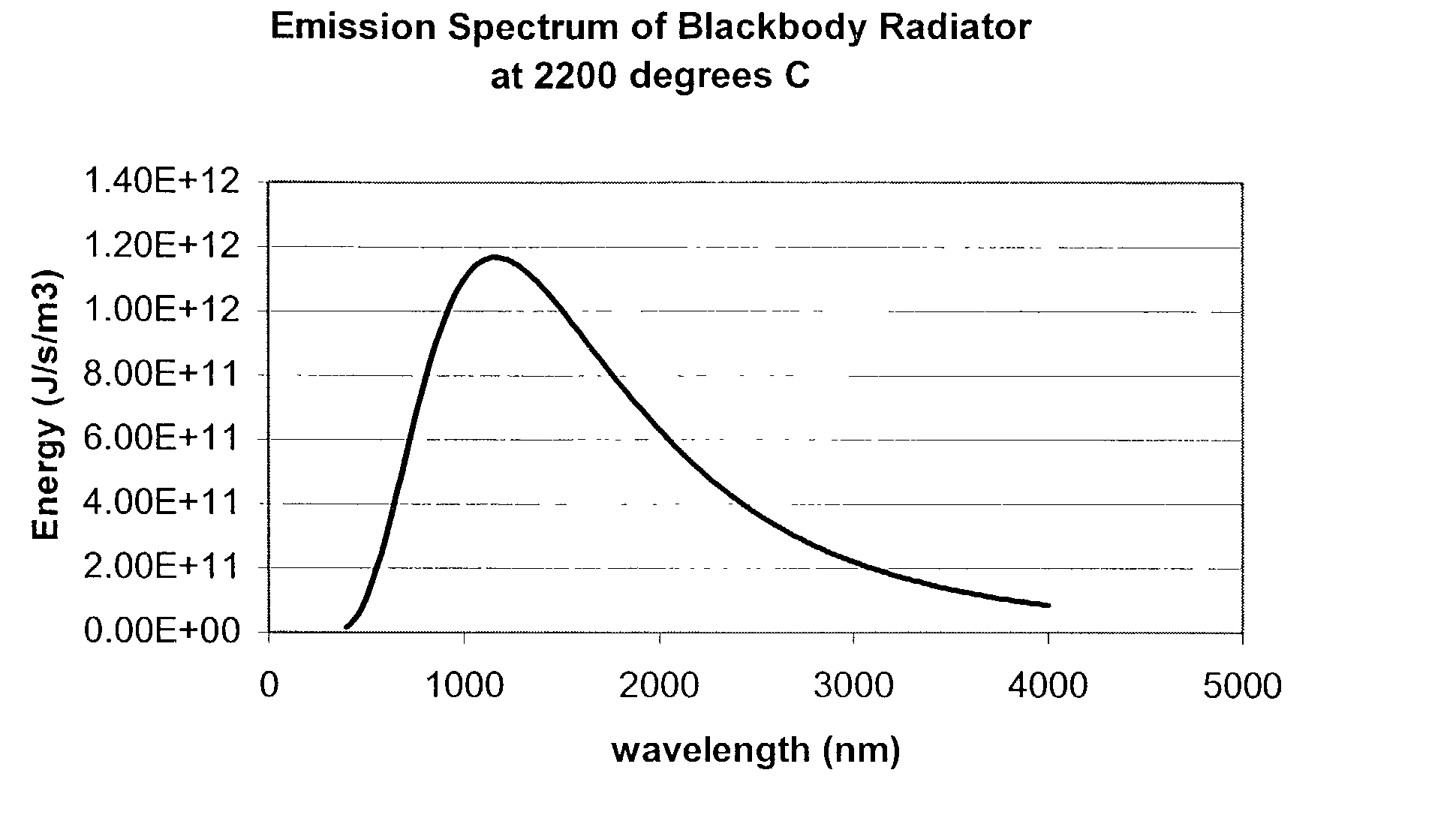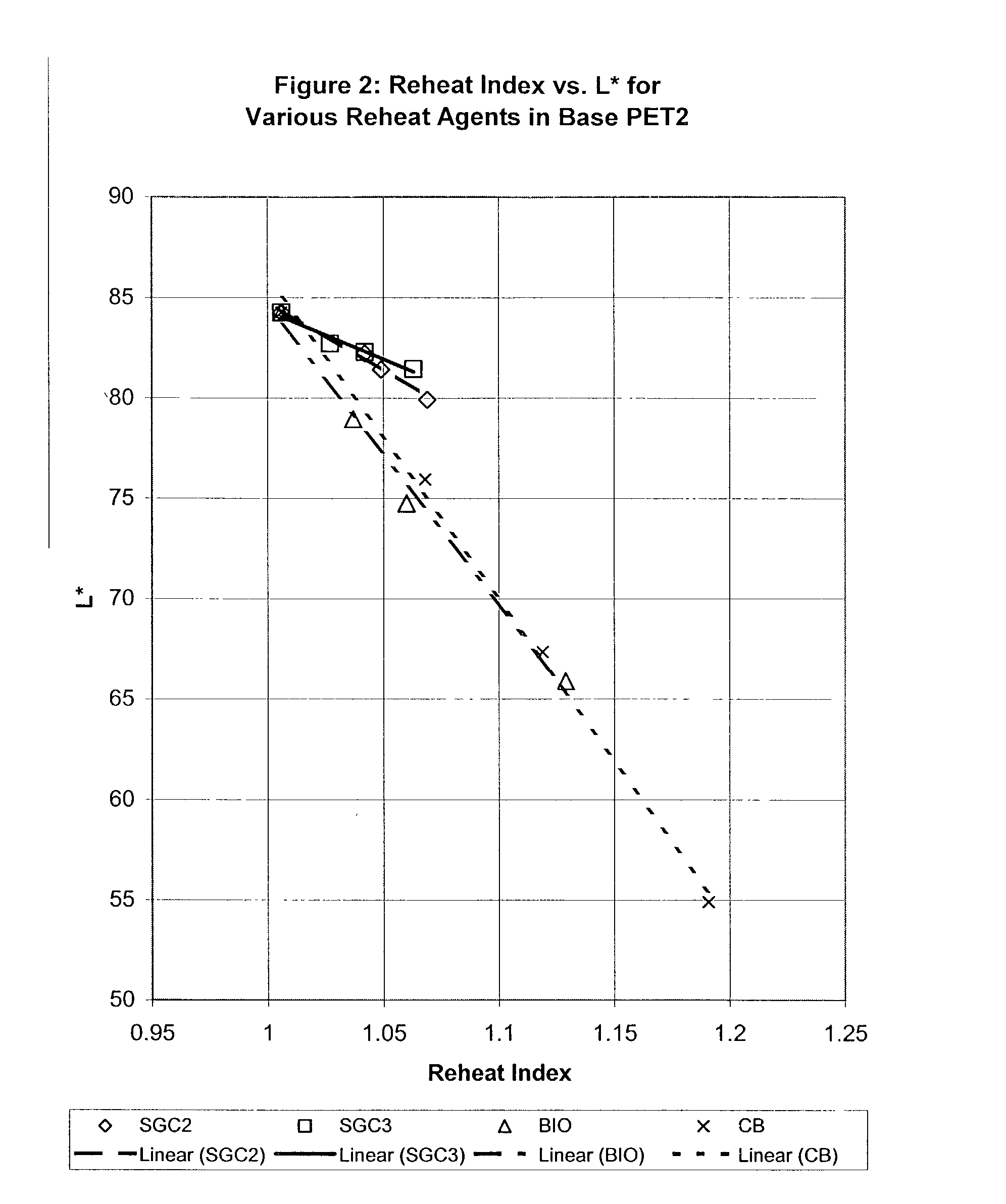Glassy carbon thermoplastic compositions
a technology of glassy carbon and compositions, applied in the field of polymer compositions, can solve the problems of poor energy absorption of pets, negative effect on the visual appearance of pet bottles, darkening, becoming less bright and more hazy, etc., and achieves good reheating rate, improved l* and b* ratings, and low coefficient of static friction
- Summary
- Abstract
- Description
- Claims
- Application Information
AI Technical Summary
Benefits of technology
Problems solved by technology
Method used
Image
Examples
example 1
[0124] In this example, SGC2 reheat additive is compared to a BIO control. The reheat additives were combined with Base PET4 by the following method in the amounts shown in Table 1. Prior to any mixing the Base PET4 pellets were ground to a powder and dried at 150.degree. C. for 8 hours in a Conair.RTM. dehumidifying dryer. Each subsequent sample was prepared by dry blending the powder of Base PET4 with the appropriate level of reheat additive followed by hand mixing in a polyethylene bag. The mixture was then added to the feed hopper of a twin screw extruder, fitted with a set of high shear mixing screws. The extruder's vent was plugged and nitrogen was continuously fed to the feed hopper and extruder throat to exclude air. The extruder was operated at a screw speed of 200 rpm and a temperature of approximately 282.degree. C. Under these conditions the polymer residence time in the extruder's barrel was approximately three minutes. The extrudate was quenched in an ice water bath an...
example 2
[0127] The purpose of this example is to compare SGC2 and SGC3 reheat additives to BIO and CB reheat additives. Blends of these additives in Base PET2 were prepared in the following manner. Each additive was dry blended in a glass bottle with Base PET2 that had been cryogenically ground to a particle size that was small enough to pass through a sieve with 3-mm diameter circular holes. The reheat additive loading in this concentrate mixture was 0.2 weight percent. The mixture was dried at 110.degree. C. overnight in a vacuum oven at a pressure of less than thirty inches of water. The dry mixture was melt blended in a DACA.RTM. MicroCompounder / MicroInjector, using a screw temperature of 290.degree. C. and a screw speed of 120 rpm. The mixture was circulated in the instrument for two minutes and then extruded. The resulting extrudate was cryogenically ground in a Wiley mill to produce a powder small enough to pass a screen with 3-mm diameter holes. This final melt concentrate was then ...
example 3
[0134] Lab-scale polymer preparations were made to evaluate the impact of prolonged exposure of the SGC additive to typical PET manufacturing conditions of temperature and pressure. The general synthetic procedure is described below for the preparation of a Base PET5. This example also demonstrates the addition of the reheat additive to a polyethylene terephthalate process in the melt phase at the prepolymer stage of manufacture before polycondensation in a finishing stage. Polymers prepared via this route were used to prepare discs for evaluation of color, reheat and haze values. The reheat additives evaluated in this manner were: SGC1 (0-150 ppm), SGC2 (0-200 ppm), CB (0-10 ppm), GR(0-150 ppm) and RA. RA was formed in-situ by the addition of phosphorous acid reducing agent.
[0135] A typical charge of reactant to a 5-L three-necked round bottom flask is shown in the table below.
3 Reactant Amount (grams) Dimethyl terephthalate 1941.9 Ethylene glycol 1230.23 1,4-Cyclohexanedimethanol ...
PUM
| Property | Measurement | Unit |
|---|---|---|
| Length | aaaaa | aaaaa |
| Length | aaaaa | aaaaa |
| Fraction | aaaaa | aaaaa |
Abstract
Description
Claims
Application Information
 Login to View More
Login to View More - R&D
- Intellectual Property
- Life Sciences
- Materials
- Tech Scout
- Unparalleled Data Quality
- Higher Quality Content
- 60% Fewer Hallucinations
Browse by: Latest US Patents, China's latest patents, Technical Efficacy Thesaurus, Application Domain, Technology Topic, Popular Technical Reports.
© 2025 PatSnap. All rights reserved.Legal|Privacy policy|Modern Slavery Act Transparency Statement|Sitemap|About US| Contact US: help@patsnap.com



